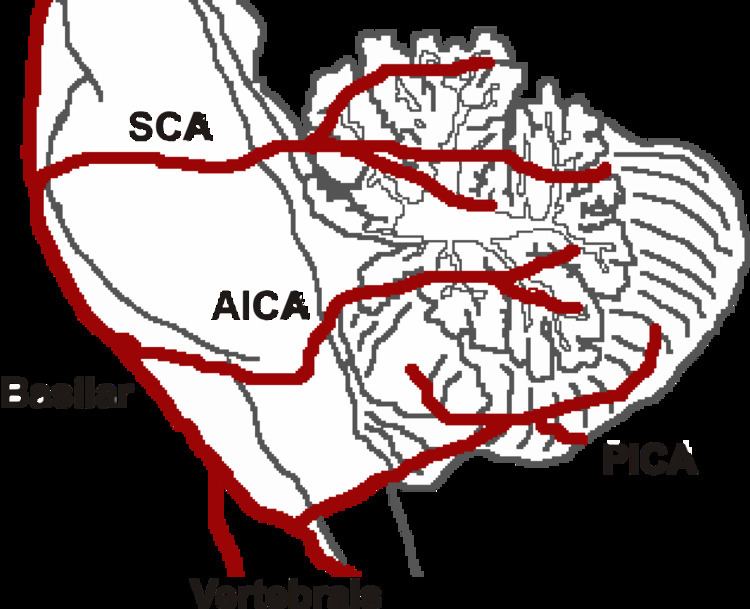ICD-9-CM 344.81 | ICD-10 G93.8 MeSH D011782 | |
 | ||
Locked-in syndrome (LIS) is a condition in which a patient is aware but cannot move or communicate verbally due to complete paralysis of nearly all voluntary muscles in the body except for vertical eye movements and blinking. The individual is conscious and sufficiently intact cognitively to be able to communicate with eye movements. Total locked-in syndrome, or completely locked-in state (CLIS), is a version of locked-in syndrome wherein the eyes are paralyzed as well. Fred Plum and Jerome Posner coined the term for this disorder in 1966. Locked-in syndrome is also known as cerebromedullospinal disconnection, de-efferented state, pseudocoma, and ventral pontine syndrome.
Contents
Presentation
Locked-in syndrome usually results in quadriplegia and the inability to speak in otherwise cognitively intact individuals. Those with locked-in syndrome may be able to communicate with others through coded messages by blinking or moving their eyes, which are often not affected by the paralysis. The symptoms are similar to those of sleep paralysis. Patients who have locked-in syndrome are conscious and aware, with no loss of cognitive function. They can sometimes retain proprioception and sensation throughout their bodies. Some patients may have the ability to move certain facial muscles, and most often some or all of the extraocular muscles. Individuals with the syndrome lack coordination between breathing and voice. This prevents them producing voluntary sounds, though the vocal cords are not paralysed.
Causes
Unlike persistent vegetative state, in which the upper portions of the brain are damaged and the lower portions are spared, locked-in syndrome is caused by damage to specific portions of the lower brain and brainstem, with no damage to the upper brain.
Possible causes of locked-in syndrome include:
Curare poisoning mimics a total locked-in syndrome by causing paralysis of all voluntarily controlled skeletal muscles. The respiratory muscles are also paralyzed, but the victim can be kept alive by artificial respiration, such as mouth-to-mouth resuscitation. In a study of 29 army volunteers who were paralyzed with curare, artificial respiration managed to keep an oxygen saturation of always above 85%, a level at which there is no evidence of altered state of consciousness. Spontaneous breathing is resumed after the end of the duration of action of curare, which is generally between 30 minutes and eight hours, depending on the variant of the toxin and dosage.
Diagnosis
Locked-in syndrome can be difficult to diagnose. In a 2002 survey of 44 LIS patients, it took almost 3 months to recognize and diagnose LIS after the patient had suffered the incident (i.e., a stroke or an injury) that had caused his/her LIS. Locked-in syndrome may mimic loss of consciousness in patients, or, in the case that respiratory control is lost, may even resemble death. Patients are also unable to actuate standard motor responses such as withdrawal from pain; as a result, testing often requires making requests of the patient such as blinking or vertical eye movement.
Brain imaging may provide additional indicators of locked-in syndrome, as brain imaging provides clues as to whether or not brain function has been lost. Additionally, an EEG can allow the observation of sleep-wake patterns indicating that the patient is not unconscious but simply unable to move.
Treatment
Neither a standard treatment nor a cure is available. Stimulation of muscle reflexes with electrodes (NMES) has been known to help patients regain some muscle function. Other courses of treatment are often symptomatic. Assistive computer interface technologies, such as Dasher, or OptiKey, combined with eye tracking, may be used to help patients communicate.
Prognosis
It is extremely rare for any significant motor function to return. The majority of locked-in syndrome patients do not regain motor control, but devices are available to help patients communicate. However, some people with the condition continue to live much longer, while in exceptional cases, like that of Kerry Pink and Kate Allatt, a full spontaneous recovery may be achieved.
Research
New direct brain interface mechanisms may provide future remedies. One effort in 2002 allowed a fully locked-in patient to answer yes-or-no questions; others reported in 2017 having repeated this result with a larger study. In 2006, researchers created and successfully tested a neural interface which allowed someone with locked-in syndrome to operate a web browser. Some scientists have reported that they have developed a technique that allows locked-in patients to communicate via sniffing.
